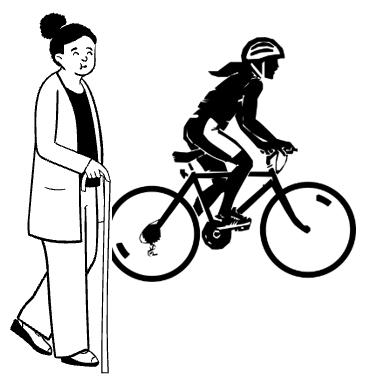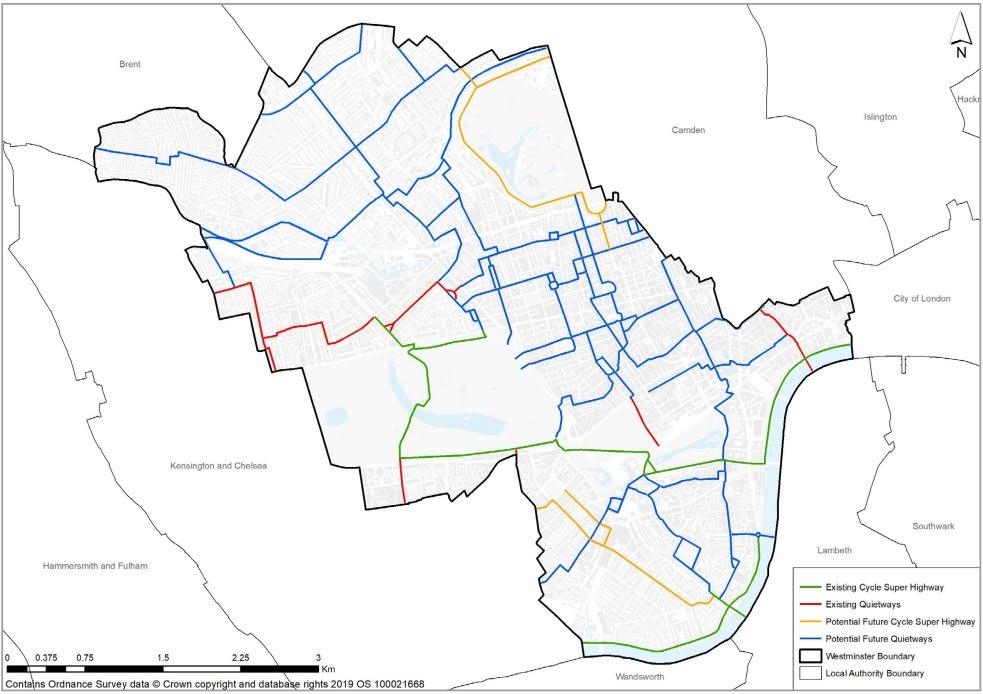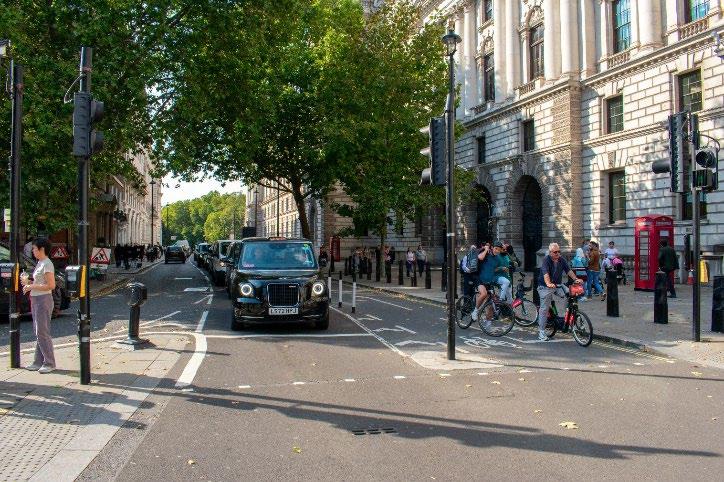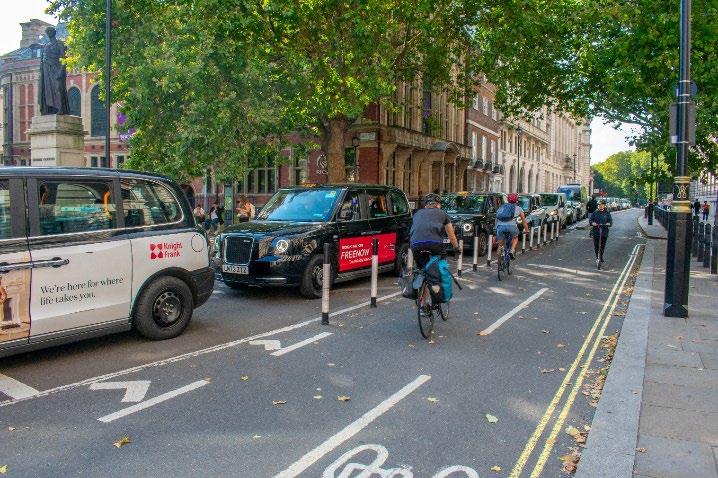4.2 Cycling / Active Travel
Related SPD sections
Key City Plan policies
• 4 1 Highway space
• 4.5 Street Furniture
• 4 13 Signs and Adverts
24. Sustainable Transport
25. Walking and Cycling
28. Highway Access and Management
43. Public realm

City Plan policy 25 requires that developments deliver a first-class public realm which supports cycling through ensuring a safe and accessible environment, providing for connected, high quality cycle routes in line with or exceeding London Cycle Design Standards, and achieving improvements to signage. It requires schemes to enable and contribute towards improvements to cycle access, including the delivery of current and planned cycle routes and to meet the cycle parking and cycle facilities standards in the London Plan.
Policy 25 seeks to ensure that developments promote cycling and provide a safe and accessible environment for cyclists, while not compromising the needs of pedestrians The policy further requires that schemes provide links to public transport nodes, contribute towards improved wayfinding, and promote and contribute towards the introduction and expansion of cycle hire facilities.
The sense of safety is a significant determinant of cycling in the city While segregated lanes are not always possible on Westminster’s streets given the constraints of a dense and historic built environment, it is important that cycle lanes are of generous widths that can accommodate a range of different kinds of bicycles. This is to ensure they can cater for a range of cyclists of different abilities, making cycling an accessible and safe mode of transport
Context
The City Council is committed to improving conditions for cyclists and encouraging other sustainable travel options. This will be achieved through a variety of interventions including developing the cycle network, upgrading the public realm, managing parking demand, reducing severance, proactively place shaping, and implementing junction improvements and traffic calming measures.
Space in Westminster is in high demand as competing uses have their individual impact on the street scape and highway space. The space demands for cyclists are often relatively small and easier to safely integrate within street spaces, when compared to other transport options. The minimum policy requirement for cycle parking associated with a development must be met within the development itself and not on highway.
Cycling as a modal share of transport in Westminster is relatively low, however it is increasing. This is an important part of tackling the climate emergency and transitioning as a city to Net Zero. Understanding and addressing the barriers to cycling, and other sustainable transport choices such as e-scooters, is vital in order to increase the modal share Furthermore,
active travel, such as cycling increases daily physical activity and the amount of time spent outside. These are factors that play a crucial role in promoting positive physical and mental health.
Those using bicycles, e-scooters, or similar vehicles will often have strong preferences towards desire lines to minimise distances travelled, or to avoid other hazards such as busy roads and air pollution. Failure to create direct permeability for these highway users could lead to unintended misuse of footways Legibility of cycle routes, for both cyclists, car users, and pedestrians, is also important. Clear boundaries are likely to reduce potential conflicts between road users, while segregated lanes may not always be possible Cycle parking facilities in the public realm are also an important piece of street furniture to encourage greater use of bicycles.
Through co-ordinated efforts to improve the environment for cyclists, cycling can become a more attractive transport option resulting in an increased modal shift away from private car use.
A number of TfL designated cycle routes already permeate through the city (see figure 16) Facilitating safe connection to these routes, is of key importance when planning for the public realm, especially where there are existing desire lines for cyclists. The City Council will work with the Mayor’s office, Tf L and neighbouring authorities towards the implementation of a central London cycling grid.
TfL cycle hire docking stations, dockless bicycles and other similar modes of transport are not considered to be substitutes from developments providing their minimum policy requirement long and short stay cycle parking within their development sites (and not on highway).

New safe and legible cycle routes:
When planning new routes, regard will be had to existing and proposed wider strategic London-wide cycle routes, and providing connectivity, with efforts made to integrate new infrastructure with the existing network.
A. Development in the public realm should improve connectivity to existing and proposed Cycleway and Quietway routes.
B. Schemes located between two existing routes should facilitate cycling connections.
C. Schemes should incorporate cycle permeability. This includes ensuring they do not block established cycling and walking pathways.
D. Walking and cycling routes should be designed with clear road and footway markings and unambiguous signage at eye level to indicate where cyclists or pedestrians may be present and to improve visibility of cycle routes
E. Cycle lane surfaces should be smooth, sealed, solid and visually contrasted with other surface uses. For example, they should be visually distinct from bus lanes and other road surfaces.
F. Segregated cycle paths should be considered where space permits (see example in figure 17)
G. Creating small sections of shared space to promote cycle and pedestrian permeability will generally be supported, provided that adequate design mechanisms are used to help more vulnerable pedestrians negotiate the route safely and equally
H. Cycling routes should be designed with appropriate illumination
Dimensions and placement of cycling routes:
I. Where practical, one lane cycleways that run alongside the carriageway, whether segregated or not, should be a minimum of 2 meters in width.
J. Where practical, two-way cycleways should be a minimum of 4 metres 29 in width
K. The available width of the carriageway will dictate the location of the cycle lane, although lanes that place cyclists within the ‘door zone’ of parked cars should be avoided. If car parking is retained, floating parking arrangements where vehicles are parked to the right of the cycle lane could be considered.
L. New routes should comply with LTN1/20
New cycle parking:
M. Development likely to generate increased visitors or is nearby or adjacent to public transport (in particular, National Rail stations) should include increased provision of on-street cycle parking (Policy 25).
N. Adjacent to National Rail stations, development should provide larger scale parking facilities that meet the cycle standards in the London Plan.
O. Schemes located close to cycleways or quiet routes should also include enhanced provision of cycle parking.
P. In residential areas, cycle hangars that allow secure overnight storage of bicycles should prioritised. All new facilities should be installed in line with guidance set out in Chapter 5.6 Street Furniture of this SPD
Q. Cycle parking should be designed to be clearly defined, contrasting visually with the surrounding background. The use of tactile paving to ensure the area is identifiable is encouraged
R. The design of cycle parking should provide space for adapted cycles and step free access.
Cycle and e-scooter hire facilities:
S. Opportunities for increased provision of public cycle (or e-scooter) hire schemes should be explored when planning development in the public realm.
T. Private hire cycles and e-scooters will be expected to use designated bays with clear signage and road markings.
Sustainable last mile:
U. Schemes should explore opportunities for facilitating and improving access by cargo delivery bicycles - including dedicated on-street loading bays and anchors. Where roadside parking bays are not appropriate, dedicated wide bicycle cycle storage on the footway can be considered. These should be located adjacent to commercial uses, and
consideration should be given to future proofing bays for the installation of e-bike/scooter facilities. The City Council also supports the introduction of new e-bike delivery centres to contribute to reaching net-zero.
Further information
For more information about legible cycle routes and wayfinding guidance please refer to Cycle infrastructure design (LTN1/20) The City Council also has published a Cycling Strategy which outlines how the council will support and encourage cycling in Westminster.
Where a route or facility forms part of the London Cycleway network, the City Council works with TfL to assign a cycleway number ("Cxx") and incorporate any additional wayfinding needed to integrate the route with the wider Cycleway network.


